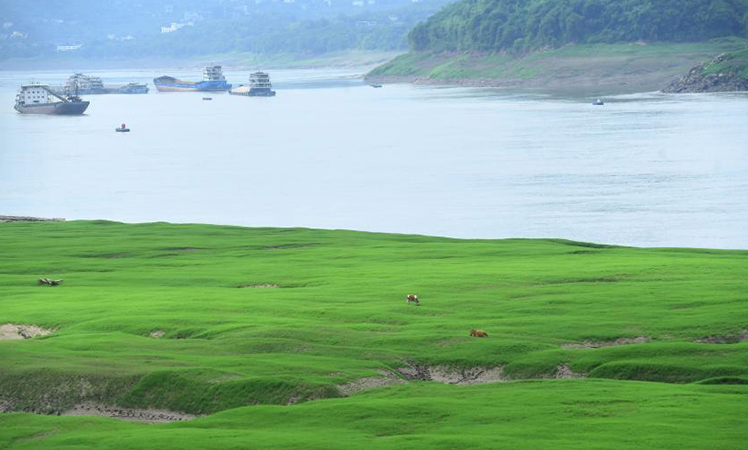Roundup: Europe faces unusual mid-June heatwave
PARIS, June 19 (Xinhua) -- Europe is facing a heatwave this week following an unusually early and intense heatwave coming from North Africa, with governments of many European countries issuing warnings to the public and instructions on how to "survive" it.
In France, monthly heat records were recorded in several cities, according to the Meteo Channel.
According to news daily Le Figaro, an absolute record for the Southwestern seaside city of Biarritz was recorded at 42.4 degrees Celsius, with an average of 35 degrees Celsius in other regions in France.
A total of 14 French departments were on heatwave red alert on Friday by the Meteo Channel, which then reduced the number to 11 for Saturday.
About three-quarters of the French population are affected by the orange and red heatwave alert.
On Saturday evening, the situation remains extreme, unprecedented, with exceptionally high temperatures never before observed so early in the season, Le Figaro reported.
The French government has also set up a "heat" line to help people in need in case of emergency.
Across the English Channel, Britain's Met Office on Friday issued a level-three warning, the second highest, for the heatwave in London, southeast and east England, as the temperature rose to 33 degrees Celsius, the highest since summer 2020.
The British Health Security Agency has issued a level-three heat-health alert across London, the southeast and east England, which requires social and healthcare services to target specific actions at high-risk groups.
Stephen Dixon, a Met Office spokesperson, told the media that temperatures in the early 30s were "not unprecedented but it is unusual to see temperatures this high this early in the year."
"What we've been noticing for the last few years is that even when we get these brief spells of heat, these bursts of heat from the South making our way ... they do tend to be really intense," meteorologist Tomasz Schafernaker told the BBC Newscast podcast this week.
"We're going to be pushing the mid-30s, that is something that you are starting to see more frequently, so an indication of that climate perhaps shifting," he said.
The heatwave has also swept across Italy this week, sparking emergencies in at least four cities and putting half of the agricultural production in the north at drought risk.
An orange heat emergency, the second highest emergency level, was declared Friday in the northern cities of Brescia and Turin, as well as Florence and Perugia in central Italy. The most vulnerable, the elderly, children, the chronically ill, and pregnant women are advised to stay indoors during the hottest hours of the day.
Temperatures in some parts of the north topped 40 degrees Celsius on Friday.
The agricultural association Agricotori Italiani said as much as half of the agricultural production in northern Italy was now at risk due to drought conditions.
It said the precipitation volume in these areas so far this year was only half of last year's volume, and the caused damage is estimated at 1 billion euros (1.1 billion U.S. dollars).
According to Alberto Cirio, governor of the Piedmont region where Turin is located, the Po River, Italy's longest waterway crucial to agricultural irritation, is 72 percent below its normal water level.
He said some parts of the region had not reported any rain for more than 110 days, a situation that was exacerbated by a lack of snowfall in the winter months.
In Spain, temperatures reaching 42 degrees Celsius that have put 11 of Spain's 17 autonomous communities on orange alert for high temperatures, continue to fuel a series of wildfires that have destroyed around 13,000 hectares of forest and scrubland in several parts of northern Spain over the past three days.
Rescue services have reported fires in the communities of Catalonia, Navarra, Aragon and Castile-Leon, where a fire in the Meseta Iberica in Sierra de la Culebra hills in the province of Zamora has devastated 9,000 hectares.
The fire has also led to the evacuation of 650 people from their homes in several small towns, after being started by a lightning strike on Wednesday night.
Three further fires in Catalonia have so far destroyed 2,000 hectares, although the Catalan fire brigade warns that high temperatures and strong winds mean these fires have the potential to spread a lot more.
Over 1,200 hectares of woodland have also been burned close to the city of Zaragoza in Aragon, after strong overnight winds helped to double the size of the fire, which began on Thursday.
These fires are taking place in the context of the worst June heatwave in over 20 years, which has lasted for a week and is expected to continue until at least Sunday.
One of the hottest Junes on record followed the driest May since records began and Spanish state TV network, RTVE reported on Wednesday that 19,000 hectares of land had already been destroyed by wildfires in 2022. This is twice the damage caused in the same period in 2021, and the damage has increased considerably in the past 48 hours.
Meanwhile, reservoirs in Spain are at an average of 48 percent capacity, which is 10 percent down on 2021 and 20 percent lower than the average for the last 10 years.
Asked about the cause of the heatwave, Clare Nullis, from the World Meteorological Organization, said although it was only mid-June, temperatures were more typical of those witnessed in Europe in July or August.
"In some parts of Spain and France, temperatures were more than 10 degrees Celsius higher than the average for this time of year. This was combined with drought in many parts of Europe," she said.
According to Nullis, because of climate change, heatwaves were starting earlier and were becoming more frequent and more severe because of record concentrations of heat-trapping greenhouse gases.
"What we were witnessing today was a foretaste of the future," she warned.
Photos
Related Stories
- Human smuggling gang busted in central, eastern Europe
- Europe faces non-energy challenges amid Ukraine crisis, experts say
- Guest Opinion: What has Europe lost from the Ukraine crisis?
- Euro area fiscal policy to remain "agile and flexible" amidst Russia-Ukraine conflict
- From bourses to dinner tables, Ukraine crisis affecting prices in Europe
- Removing Russian banks from SWIFT could be double-edged sword for Europe
- Europe seeks strategic autonomy in de-escalating Ukraine crisis
- Semiconductors, food supplies at risk amid elusive situation in Europe
- U.S. to deploy additional 3,000 troops to Europe amid Ukraine tensions
- Economic Watch: China-Europe trade shows resilience with strong performance in 2021
Copyright © 2022 People's Daily Online. All Rights Reserved.









